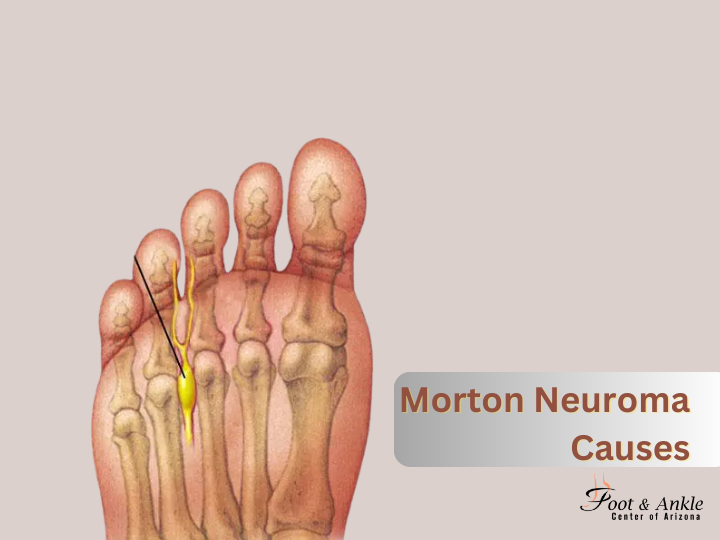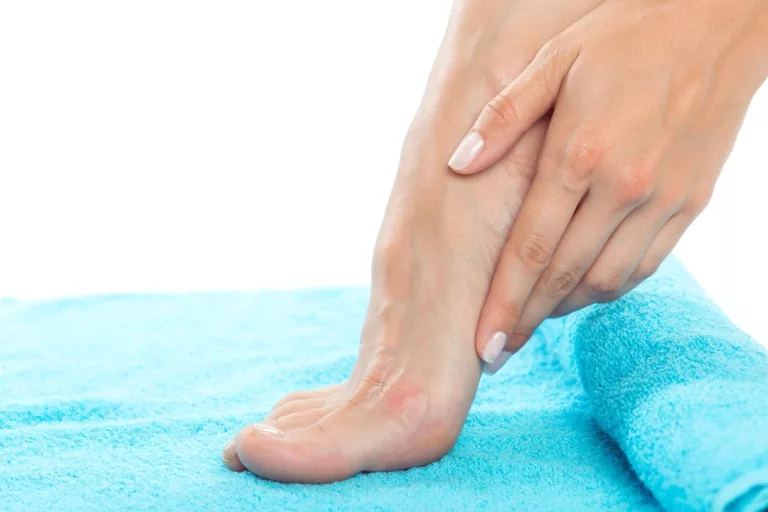Morton Neuroma is a painful condition affecting the ball of the foot, most commonly between the third and fourth toes. It occurs when the tissue surrounding one of the nerves leading to the toes thickens, causing irritation, inflammation, and discomfort. This condition can significantly impact daily activities and mobility if left untreated. At the Foot and Ankle Center of Arizona, we specialize in diagnosing and treating Morton Neuroma, helping patients regain comfort and mobility. Led by Dr. Kris A. DiNucci, DPM, FACFAS, our team provides expert care and advanced treatment solutions tailored to each patient’s needs.
What Causes Morton Neuroma?
Several factors contribute to the development of Morton Neuroma. Understanding these causes can help in prevention and early intervention:
1. Footwear Choices
Wearing high-heeled, narrow, or tight shoes can compress the toes and put excessive pressure on the nerves in the forefoot. This pressure may lead to nerve irritation and the formation of a neuroma over time.
2. Repetitive Stress and High-Impact Activities
Activities that involve repetitive motion or excessive pressure on the feet, such as running, dancing, or participating in high-impact sports, can increase the risk of developing Morton Neuroma. These activities place stress on the forefoot, leading to nerve irritation.
3. Foot Deformities
Individuals with structural foot abnormalities such as flat feet, high arches, bunions, or hammertoes may be more susceptible to developing Morton Neuroma. These conditions can alter weight distribution in the foot, increasing nerve compression.
4. Trauma or Injury
Direct trauma to the foot, such as a crush injury, sprain, or prolonged stress, can damage the nerves in the forefoot, potentially leading to Morton Neuroma. Repetitive micro-injuries can also contribute to nerve thickening over time.
5. Nerve Compression or Irritation
Any condition that places additional pressure on the nerves in the foot, including swelling from arthritis or tight ligaments, can contribute to Morton Neuroma. This compression leads to inflammation and discomfort.
6. Improper Biomechanics
Poor foot posture or an abnormal gait can lead to uneven weight distribution, putting stress on certain areas of the foot. This stress can lead to nerve irritation and increase the likelihood of developing Morton Neuroma.
Symptoms of Morton Neuroma
Recognizing the symptoms of Morton Neuroma early can help with prompt diagnosis and treatment. Common symptoms include:
- Sharp or burning pain in the ball of the foot
- Tingling or numbness in the toes
- A sensation of having a pebble or lump inside the shoe
- Pain that worsens with activity or tight footwear
- Temporary relief when removing shoes or massaging the foot
If you experience these symptoms, seeking professional evaluation is crucial. At the Foot and Ankle Center of Arizona, Dr. Kris A. DiNucci, DPM, FACFAS, provides comprehensive diagnostic services to confirm Morton Neuroma and determine the best treatment plan.
Diagnosis of Morton Neuroma
Diagnosing Morton Neuroma involves a thorough medical history review and a physical examination. Dr. Kris A. DiNucci, DPM, FACFAS may also recommend imaging tests such as X-rays, ultrasound, or MRI to rule out other conditions and confirm the presence of a neuroma.
Treatment Options for Morton Neuroma
The Foot and Ankle Center of Arizona offers various treatment options tailored to each patient’s needs. Treatment typically includes:
Non-Surgical Treatments
- Footwear Modifications – Switching to wider, cushioned shoes with proper arch support can alleviate pressure on the affected nerve.
- Orthotics – Custom orthotic inserts help correct foot biomechanics and reduce stress on the nerve.
- Padding and Taping – Padding the forefoot and taping the toes can help relieve pressure.
- Physical Therapy – Stretching and strengthening exercises improve foot function and reduce symptoms.
- Medications – Anti-inflammatory medications can help reduce pain and swelling.
- Corticosteroid Injections – Targeted injections can reduce inflammation and provide temporary relief.
Surgical Treatment
If conservative treatments fail to provide relief, Dr. Kris A. DiNucci, DPM, FACFAS may recommend a surgical procedure to remove the neuroma or release the pressure on the nerve. This minimally invasive procedure can provide long-term relief and restore foot function.
Schedule an Appointment Today
If you are experiencing symptoms of Morton Neuroma, don’t wait for the pain to worsen. Contact the Foot and Ankle Center of Arizona to schedule a consultation with Dr. Kris A. DiNucci, DPM, FACFAS. Our team is here to help you find relief and get back to your daily activities pain-free.




